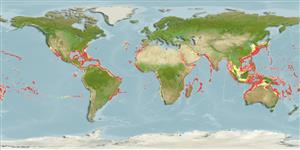>
Aulopiformes (Grinners) >
Notosudidae (Waryfishes)
Etymology: Scopelosaurus: Greek, skopelos = a lantern fish + Greek, sauros = lizard (Ref. 45335).
Environment: milieu / climate zone / depth range / distribution range
पारिस्थितिकी
समुद्री बेनथोपिलाजिक; औशिनोड़िरोमस (Ref. 6689); गहराई सीमा 50 - 815 m (Ref. 13608). Tropical; 40°N - 30°S
Eastern Atlantic: off Madeira and at 20°N 30°W. Western Atlantic: 34°N to 20°S, with some larval drift up to 40°N. Elsewhere, Indian and Pacific Oceans between 20°N and 30°S.
आकार / वज़न / Age
Maturity: Lm ? range ? - ? cm
Max length : 25.0 cm TL पुल्लिंग / अलिंग; (Ref. 6602)
Short description
आकृति विज्ञान | मौरफोमैटरिक्स
पृष्ठीय रीढ़ (सम्पूर्ण): 0; पृष्ठीय सौफट रेज़ (सम्पूर्ण): 10-12; गुदा कांटा 0; ऐनल सौफट रेज़: 17 - 19; जानवरों की रीड़ का जोड़: 53 - 56. Blackish on head and back; paler below (Ref. 6602). No distinct black spot surrounding anus (Ref. 13608).
Larvae are epipelagic, young inhabit the layers between 50-200 m, adults benthopelagic and found deeper than 500 m over continental and insular slopes (Ref. 6552, 6602). Mesopelagic (Ref. 58302). Feeds mainly on zooplankton. Extensive migrations by juveniles and adults, probably for feeding in the subtropical belts. Spawning occurs in tropical waters, especially in the western part of the Atlantic Ocean (Ref. 6689).
Life cycle and mating behavior
परिपक्व अवधि | पुनरुत्पत्ति | मछलीऔ का अंडे देना | अंडे | Fecundity | लार्वा
Krefft, G., 1990. Notosudidae. p. 361-364. In J.C. Quero, J.C. Hureau, C. Karrer, A. Post and L. Saldanha (eds.) Check-list of the fishes of the eastern tropical Atlantic (CLOFETA). JNICT, Lisbon; SEI, Paris; and UNESCO, Paris. Vol. 1. (Ref. 6552)
IUCN Red List Status (Ref. 130435)
Threat to humans
Harmless
Human uses
मात्स्यिकी: कोई रुचि बग़ैर
अधिक जानकारी
आम नामउपशब्दचपायचयपरभक्षीईकोटोकसीकोलौजीपुनरुत्पत्तिपरिपक्व अवधिमछलीऔ का अंडे देनाSpawning aggregationFecundityअंडेEgg development
Age/Sizeबाढ़Length-weightLength-lengthLength-frequenciesमौरफोमैटरिक्सआकृति विज्ञानलार्वालारवल गतिकीभर्तीबहुतायतBRUVS
संदर्भजलीयकृषिजलीयकृषि रूपरेखाखींचआनुवंशिकीElectrophoresesहैरेटिबिलटीबीमारीप्रक्रमणNutrientsMass conversion
सहयोगीयोतस्वीरेStamps, Coins Misc.ध्वनिसिगुयटिरारफ्तारतैरने के प्रकारगिल क्षेत्रOtolithsदिमागदृष्टि
साधन
Special reports
Download XML
इंटरनेट स्रोत
Estimates based on models
Preferred temperature (Ref.
123201): 9.6 - 20.6, mean 14.5 °C (based on 680 cells).
Phylogenetic diversity index (Ref.
82804): PD
50 = 0.5001 [Uniqueness, from 0.5 = low to 2.0 = high].
Bayesian length-weight: a=0.00288 (0.00120 - 0.00692), b=3.18 (2.96 - 3.40), in cm total length, based on LWR estimates for this (Sub)family-body shape (Ref.
93245).
Trophic level (Ref.
69278): 3.4 ±0.45 se; based on food items.
Fishing Vulnerability (Ref.
59153): Low vulnerability (15 of 100).
